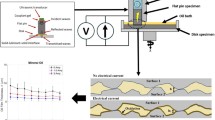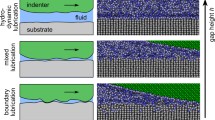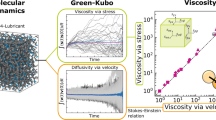Abstract
In the vicinity of the top dead center of a diesel engine, the piston rings operate in a low-speed, high-load, and high-temperature environment, which is detrimental to the formation of an effective lubrication oil film. Consequently, it presents significant challenges for predicting the tribological characteristics of the piston ring-cylinder liner friction (PRCL) assembly. This study explores the micro-friction behavior of PRCL assemblies near the top dead center in engines using the molecular dynamics approach. The tribological characteristics of the PRCL, especially the microscopic wear mechanisms, were analyzed under various operating conditions such as ring sliding speed, ring back load, operating temperature, and lubricant supply amount. The liner surface morphology, liner wear, and lubricant film distribution were used to evaluate the tribological characteristics. It was determined that the lubricant supply amount has the most significant impact on the micro-friction behavior of the PRCL assembly.
Graphical Abstract
















Similar content being viewed by others
References
Wu, J., Wang, L., Li, Z., Liu, P., Zhang, C.: Thermal analysis of lubricated three-dimensional contact bodies considering interface roughness. Front. Mech. Eng-Prc. 17(2), 16 (2022)
Shi, X., Lu, X., Feng, Y., Qiu, Z.: Tribo-dynamic analysis for aero ball bearing with 3D measured surface roughness. Eng. Fail. Anal. 131, 105848 (2022)
Cheng, S., Meng, X., Li, R.: Rough surface damping contact model and its space mechanism application. Int. J Mech. Sci. 214, 106899 (2022)
Lyu, B., Zhang, L., Meng, X., Wang, C.: A boundary lubrication model and experimental study considering ZDDP tribofilms on reciprocating friction pairs. Tribol. Lett. 70(2), 65 (2022)
Dong, Q., Wang, Z., Zhu, D., Meng, F., Xu, L., Zhou, K.: A model of mixed lubrication based on non-normalized discretization and its application for multilayered materials. J Tribol-T. ASME 141(4), 042101 (2019)
Bair, S., Khonsari, M., Winer, W.O.: High-pressure rheology of lubricants and limitations of the Reynolds equation. Tribol. Int. 31(10), 573–586 (1998)
Chen, P., Wang, X., Wang, P., He, A.: A mesoscale study of micro-spallation of Cu through coarse-grained molecular dynamics modeling. Int. J Mech. Sci. 220, 107122 (2022)
Pan, Z., Fu, Y., Wei, Y., Yan, X., Luo, H., Li, X.: Deformation mechanisms of TRIP-TWIP medium-entropy alloys via molecular dynamics simulations. Int. J Mech. Sci. 219, 107098 (2022)
Song, W., Yu, Y., Guan, Y.: Role of void shape on shock responses of nanoporous metallic glasses via molecular dynamics simulation. Int. J Mech. Sci. 218, 107076 (2022)
Wang, B., Kang, G., Yu, C., Gu, B., Yuan, W.: Molecular dynamics simulations on one-way shape memory effect of nanocrystalline NiTi shape memory alloy and its cyclic degeneration. Int. J Mech. Sci. 211, 106777 (2022)
Latypov, F.T., Fomin, E.V., Krasnikov, V.S., Mayer, A.E.: Dynamic compaction of aluminum with nanopores of varied shape: MD simulations and machine-learning-based approximation of deformation behavior. Int. J. Plasticity 156, 103363 (2022)
Ootani, Y., Xu, J., Adach, K., Kubo, M.: First-principles molecular dynamics study of silicon-based ceramics: different tribochemical reaction mechanisms during the running-in period of silicon nitride and silicon carbide. J. Phys. Chem. C 124(37), 20079–20089 (2022)
Li, Z., Wang, J., Yang, Y., et al.: Friction-induced construction of PTFE-anchored MXene heterogeneous lubricating coating and its in-situ tribological transfer mechanism. Chem. Eng. J. 442(2), 136238 (2022)
Ta, T.D., Le, H., Tieu, A.K.: Reactive molecular dynamics study of hierarchical tribochemical lubricant films at elevated temperatures. ACS Appl. Nano Mater. 3(3), 2687–2704 (2020)
Konishi, M., Washizu, H.: Understanding the effect of the base oil on the physical adsorption process of organic additives using molecular dynamics. Tribol. Int. 149, 105568 (2020)
Dasic, M., Stankovic, I., Gkagkas, K.: Molecular dynamics investigation of the influence of the shape of the cation on the structure and lubrication properties of ionic liquids. Phys. Chem. Chem. Phys. 21, 4375–4386 (2019)
Stribeck, R.: Die wesentilchen eigenschaften der gleit und rollenlager, Part 1. Zeitschrift des Vereines Deutscher Ingenieure. 46(37), 1341–1348 (1902)
Stribeck, R.: Die wesentilchen eigenschaften der gleit und rollenlager, Part 2. Zeitschrift des Vereines Deutscher Ingenieure. 46(38), 1432–1438 (1902)
Stribeck, R.: Die wesentilchen eigenschaften der gleit und rollenlager, Part 3. Zeitschrift des Vereines Deutscher Ingenieure. 46(39), 1463–1470 (1902)
Song, J., Zhao, G.: A molecular dynamics study on water lubrication of PTFE sliding against copper. Tribol. Int. 136, 234–239 (2019)
Zhu, Y., Zhang, Y., Shi, Y., Lu, X., Li, J., Lu, L.: Lubrication behavior of water molecules confined in TiO2 nanoslits: a molecular dynamics study. J. Chem. Eng. Data 61(12), 4023–4030 (2016)
Shi, J., Chen, J., Sun, K., Sun, J., Han, J., Fang, L.: Water film facilitating plastic deformation of Cu thin film under different nanoindentation modes: a molecular dynamics study. Mater. Chem. Phys. 198, 177–185 (2017)
Shi, J., Yi, X., Wang, J., Ge, J., Li, H., Fan, X.: Traction behavior and mechanism of molecular level with effects of molecular structure and sliding velocity in boundary lubrication regime: a molecular dynamics study. J. Mol. Liq. 354, 118844 (2022)
Pan, L., Gao, C.: Confined fluid density of a pentaerythritol tetraheptanoate lubricant investigated using molecular dynamics simulation. Fluid Phase Equilib. 385, 212–218 (2015)
Xia, L., Long, J., Zhao, Y., Wu, Z., Dai, Z., Wang, L.: Molecular dynamics simulation on the aggregation of lubricant oxidation products. Tribol. Lett. 66, 104 (2018)
Wu, L., Keer, M.L., Lu, J., Song, B., Gu, L.: Molecular dynamics simulations of the rheological properties of graphene-PAO nanofluids. J. Mater. Sci. 53(23), 15969–15976 (2018)
Ren, J., Zhao, J., Dong, Z., Liu, P.: Molecular dynamics study on the mechanism of AFM-basednanoscratching process with water-layer lubrication. Appl. Surf. Sci. 346, 84–98 (2015)
Lu, J., Wang, Q.J., Ren, N., Lockwood, E.F.: Correlation between pressure-viscosity coefficient and traction coefficient of the base stocks in traction lubricants: a molecular dynamic approach. Tribol. Int. 134, 328–334 (2019)
Lin, L., Kedzierski, A.M.: Density and viscosity of a polyol ester lubricant: measurement and molecular dynamics simulation. Int. J. Refrig. 118, 188–201 (2020)
Cunha, M.A.G., Robbins, M.O.: Determination of pressure-viscosity relation of 2,2,4-trimethylhexane by all-atom molecular dynamics simulations. Fluid Phase Equilib. 495, 28–32 (2019)
Jiang, T., Deng, F., Wu, Y., Feng, Q., Zou, S., Huang, F.: Molecular dynamics simulation and experimental study of tribological behavior of dimethyl carbonate-diesel blends in synthetic base oil. Tribol. T. 64(3), 392–402 (2021)
Zheng, X., Su, L., Deng, G., Zhang, J., Zhu, H., Tieu, A.K.: Study on lubrication characteristics of C4-alkane and nanoparticle during boundary friction by molecular dynamics simulation. Metals 11(9), 1464 (2021)
Gkagkas, K., Ponnuchamy, V., Dasic, M., Stankovic, I.: Molecular dynamics investigation of a model ionic liquid lubricant for automotive applications. Tribol. Int. 113, 83–91 (2017)
Zhang, L., Lu, B., Wu, Y., et al.: Molecular dynamics simulation and experimental study on the lubrication of graphene additive films. P. I. Mech. Eng. J-J. Eng. 234(12), 1957–1972 (2020)
Liu, P., Yu, H., Ren, N., Lockwood, F.E., Wang, Q.J.: Pressure-viscosity coefficient of hydrocarbon base oil through molecular dynamics simulations. Tribol. Lett. 60(3), 34 (2015)
Washizu, H., Ohmori, T., Suzuki, A.: Molecular origin of limiting shear stress of elastohydrodynamic lubrication oil film studied by molecular dynamics. Chem. Phys. Lett. 678, 1–4 (2017)
Bai, X., Dong, Q., Zheng, H., Zhou, K.: Modelling of non-newtonian starved thermal-elastohydrodynamic lubrication of heterogeneous materials in impact motion. Acta Mech. Solida Sin. 34(6), 954–976 (2021)
Bai, X., Dong, Q., Zheng, H., Zhou, K.: A finite element model for non-newtonian starved thermal-elastohydrodynamic lubrication of 3D line contact. Int. J. Appl. Mech. 13(9), 2150107 (2022)
Wu, S., Zhang, P., Wei, H., Chen, L.: Influence of surface texture parameters on friction characteristics under starved lubrication. Pol. Marit. Res. 27(2), 96–106 (2020)
Li, S., Masse, D.: On the flash temperature under the starved lubrication condition of a line contact. Tribol. Int. 136, 173–181 (2019)
Li, C., Tang, W., Tang, X., Yang, L., Bai, L.: A molecular dynamics study on the synergistic lubrication mechanisms of graphene/water-based lubricant systems. Tribol. Int. 167, 107356 (2022)
Yeon, J., van Duin, A.C.T., Kim, S.H.: Effects of water on tribochemical wear of silicon oxide interface: molecular dynamics (MD) study with reactive force field (ReaxFF). Langmuir 32(4), 1018–1026 (2016)
Chen, H., Zhang, G., Lu, Z., Bai, L.: Frictional behaviors of diamond-like carbon films under water lubrication: a molecular dynamics study. Tribol. Int. 153, 106609 (2021)
Rullich, M., Weiss, V.C., Frauenheim, T.: Molecular dynamics simulations of the tribological behaviour of a water-lubricated amorphous carbon-fluorine PECVD coating. Model. Simul. Mater. Sc. 21(5), 055027 (2013)
Li, T., Jiao, B., Ma, X., Lu, X., Qiao, Z.: Optimization study of oil-feed parameters to improve the ring pack lubrication performance for a two-stroke marine diesel engine. Eng. Fail. Anal. 137, 106234 (2022)
Li, T., Ma, X., Lu, X., et al.: Lubrication analysis for the piston ring of a two-stroke marine diesel engine taking account of the oil supply. Int. J. Engine Res. 22(3), 949–962 (2021)
Bolander, N.W.: Deterministic modeling of honed cylinder liner friction. Tribol. T. 50(2), 248–256 (2007)
Lyu, X., Jiao, B., Wang, Y., et al.: An improved contact model considered the effect of boundary lubrication regime on piston ring-liner contact for the two-stroke marine engines from the perspective of the Stribeck curve. P. I. Mech. Eng. C-J Mec. 236(5), 2602–2616 (2022)
Gu, C., Meng, X., Xie, Y., Zhang, D.: The influence of surface texturing on the transition of the lubrication regimes between a piston ring and a cylinder liner. Int. J. Engine Res. 18(8), 785–796 (2018)
Plimpton, S.: Fast parallel algorithms for short-range molecular dynamics. J. Comput. Phys. 117(1), 1–19 (1995)
Wang, W., Zhang, X., Li, Y., Huang, R., Xu, J., Yang, L.: Effects of molecular structures of poly α-olefin mixture on nano-scale thin film lubrication. Mater. Today Commun. 25, 101500 (2020)
Kioupis, L.I., Maginn, E.J.: Molecular Simulation of poly-α-olefin synthetic lubricants: impact of molecular architecture on performance properties. J. Phys. Chem. B 103(49), 10781–10790 (1999)
BIOVIA Materials Studio - BIOVIA - Dassault systèmes®. San Diego, 2014
Mendelev, M.I., Han, S., Srolovitz, D.J., Ackland, G.J., Sun, D.Y., Asta, M.: Development of new interatomic potentials appropriate for crystalline and liquid iron. Philos. Mag. 83(35), 3977–3994 (2003)
Choi, W.M., Kim, Y., Seol, D., Lee, B.J.: Modified embedded-atom method interatomic potentials for the Co-Cr, Co-Fe, Co-Mn, Cr-Mn and Mn-Ni binary systems. Comp. Mater. Sci. 130, 121–129 (2017)
Lorentz, H.A.: Ueber die anwendung des satzes vom virial in der kinetischen theorie der gase. Ann. Phys. 248(1), 127–136 (1881)
Berthelot, D.: Comptes rendus hebdomadaires des seances de l’academie des sciences. Compt. Rendus. Acad. Sci. 126, 1703–1855 (1898)
Halicioǧlu, T., Pound, G.M.: Calculation of potential energy parameters from crystalline state properties. Phys. Status Solidi A. 30(2), 619–623 (1975)
Stukowski, A.: Visualization and analysis of atomistic simulation data with OVITO—the open visualization tool modelling. Simul. Mater. Sci. Eng. 18, 015012 (2010)
Chen, W., Liu, D., Xu, J., Huang, R., Chen, Z., Du, F., Yan, Z.: Modeling of gas pressure and dynamic behavior of the piston ring pack for the two-stroke opposed-piston engine. J. Tribol-T. ASME 141(1), 012203 (2019)
Zhang, L., Tanaka, H.: Towards a deeper understanding of wear and friction on the atomic scalem-a molecular dynamics analysis. Wear 211(1), 44–53 (1997)
Yang, Y., Huang, L., Shi, Y.: Adhesion suppresses atomic wear in single-asperity sliding. Wear 352–353, 31–41 (2016)
Funding
This work was supported by the Shandong Provincial Natural Science Foundation (ZR2022QE183, ZR2020ZD29, ZR2021JQ20, ZR2021ME168), the National Key R&D Program of China (No. 2022YFB3706204), and the Taishan Scholars Program of Shandong Province.
Author information
Authors and Affiliations
Contributions
TL contributed to the conception of the study; TL and JW performed the research method; TL and CG built the model and carried out the calculations; XM and YY collated the calculation results and drew pictures; LW and HT carried out data analysis; TL and JW edited the first draft. ZQ and HT did proofreading and reviewing.
Corresponding authors
Ethics declarations
Competing interest
The authors declare that we have no financial and personal relationships with other people or organizations that can inappropriately influence this work, and there is no professional or other personal interest of any nature or kind in any product, service, and/or company that could be construed as influencing the position presented in, or the review of, the manuscript entitled “Molecular dynamics investigation on micro-friction behavior of cylinder liner-piston ring assembly”.
Additional information
Publisher's Note
Springer Nature remains neutral with regard to jurisdictional claims in published maps and institutional affiliations.
Rights and permissions
Springer Nature or its licensor (e.g. a society or other partner) holds exclusive rights to this article under a publishing agreement with the author(s) or other rightsholder(s); author self-archiving of the accepted manuscript version of this article is solely governed by the terms of such publishing agreement and applicable law.
About this article
Cite this article
Li, T., Wu, J., Ge, C. et al. Molecular Dynamics Investigation on Micro-Friction Behavior of Cylinder Liner-Piston Ring Assembly. Tribol Lett 71, 78 (2023). https://doi.org/10.1007/s11249-023-01749-w
Received:
Accepted:
Published:
DOI: https://doi.org/10.1007/s11249-023-01749-w




